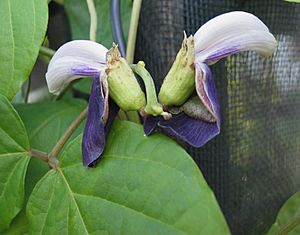Makaha Valley Jack-bean facts for kids
Quick facts for kids Makaha Valley Jack-bean |
|
|---|---|
 |
|
| Conservation status | |
| Scientific classification | |
| Kingdom: | |
| (unranked): | |
| (unranked): | |
| (unranked): | |
| Order: | |
| Family: | |
| Genus: |
Canavalia
|
| Species: |
C. napaliensis
|
| Binomial name | |
| Canavalia napaliensis H.St.John
|
|
The Canavalia napaliensis, also known as the Mākaha Valley Jack-bean, is a special flowering plant. It belongs to the pea family, called Fabaceae. This plant is endemic to Hawaii, which means it naturally grows only there and nowhere else in the world.
Long ago, you could find this plant on several Hawaiian islands, including Oʻahu's Mākaha Valley. But today, it only grows in the wild on the northwestern part of Kauaʻi. In Hawaii, this plant and other similar Canavalia species are known by the name ʻāwikiwiki.
Contents
What is the Mākaha Valley Jack-bean?
The Mākaha Valley Jack-bean is a type of flowering plant. It's part of the large pea family, which includes many plants we eat, like beans and peas. This plant is unique because it's a native Hawaiian species.
Its Appearance
Like many plants in the pea family, the Mākaha Valley Jack-bean likely has flowers that grow in clusters. These flowers would later form seed pods, similar to how peas or beans grow in a pod. The plant is adapted to the specific environments of Hawaii.
Where Does the Mākaha Valley Jack-bean Live?
This plant's natural habitats are special places in Hawaii. It grows in tropical dry forests, which are forests that don't get a lot of rain. It also lives in lowland moist forests, which are wetter. You can also find it in dry shrublands and moist shrublands. Shrublands are areas with many bushes and small trees.
Its Home on Kauaʻi
Today, the Mākaha Valley Jack-bean is found only along the Nā Pali Coast on Kauaʻi. This coast is famous for its tall, green cliffs and beautiful valleys. The plant lives in just five small groups in this area.
Why is This Plant Endangered?
The Mākaha Valley Jack-bean is in big trouble. It is listed as an endangered species. This means there are very few of these plants left in the wild, and they are at high risk of disappearing forever.
Threats to Its Survival
The main reason this plant is endangered is habitat destruction. This means the places where it naturally grows are being damaged or disappearing. A big part of this problem comes from introduced grazing mammals. These are animals like goats or pigs that were brought to Hawaii by people. They eat the plants and destroy their habitat.
How Many Plants Are Left?
Sadly, there are very few Mākaha Valley Jack-beans left. Scientists have counted no more than 206 individual plants. These plants are spread out in only five small groups along the Nā Pali Coast. Because there are so few, it's harder for them to reproduce and survive.
Conservation Efforts
In 2010, the Mākaha Valley Jack-bean was officially listed as endangered. This listing helps bring attention to the plant and its need for protection. Efforts are being made to protect its remaining habitat and help its populations grow. Protecting endangered plants like the Mākaha Valley Jack-bean is important for keeping Hawaii's unique natural environment healthy.


